
|
Home Inspectors Edition | Circulation 20,000 | Advertise | Subscribe | |
Published by OREP, E&O Insurance Experts | May 2013 |
 Click to Read Current Issue |
>
Click to Print
|
Most of us know the feeling of running out of
hot water in the middle of the shower. That will not happen with a
properly sized tankless water heater.
Inspector's Guide to Tankless Water
Heaters
by Alan Carson, Carson
Dunlop
Tankless water heaters are used extensively in Europe and other parts
of the world. They have only recently gained popularity for many
homeowners in North America. For some, it is a decision based on being
environmentally conscious, while others are more focused on cost
savings from reduced energy use. In certain homes, it is the only
viable option due to limited space available for mechanical equipment.
Whatever the reason, tankless water heaters are here to stay. As
inspectors, you should be familiar with the basic operation of these
systems.
Description
As the name suggests,
tankless water heaters have no storage capacity. They
have a powerful heater that quickly heats the water when it senses
flow. There are electric tankless heaters available, but most are gas
or propane-fired systems with a burner, heat exchanger, venting system
and controls. The heater ignites the burner when it detects water
flow. The heat exchanger heats the water as it passes through.
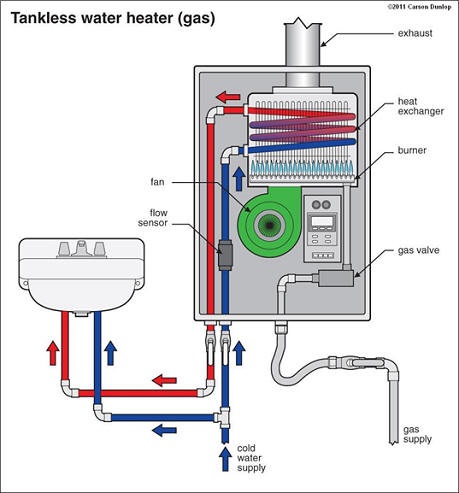
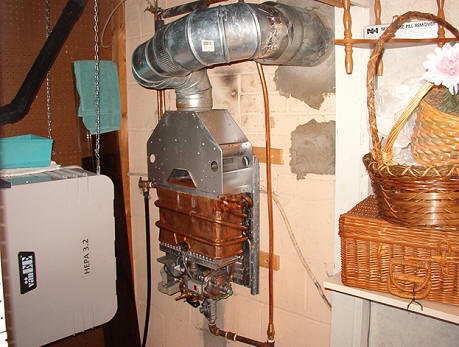 Tankless unit with cover removed – Heat exchanger, burner and gas
valve are visible
Tankless unit with cover removed – Heat exchanger, burner and gas
valve are visible
In residential applications, there is sometimes one such heater for each fixture that uses hot water. Some lower wattage units are designed to merely warm the water for hand washing.
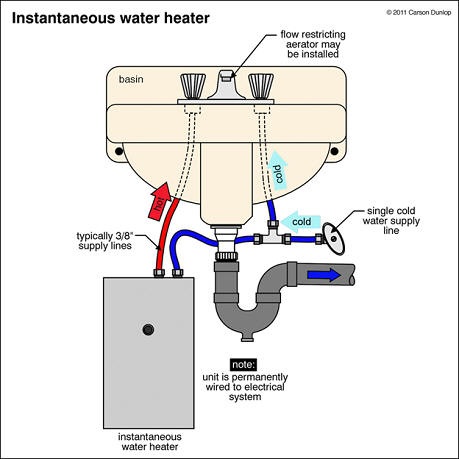
No Stored Water
Tankless water heaters cost less to operate than conventional water
heaters because there is no reservoir of idle hot water.
Hot Water Does Not Run Out
Another advantage is that you will never run out of hot water. With a
conventional tank, you can draw water off more quickly than the water
can be reheated. Most of us know the feeling of running out of hot
water in the middle of the shower. That will not happen with a
properly sized tankless water heater.
Small Size and Location
A third advantage of tankless water heaters is that they are much
smaller than conventional water heaters and take up much less room in
the house. Most are designed to hang on a wall, and many vent their
exhaust products out through the side wall of the home. Some vent
through the roof. In warm climates they are often mounted on the
exterior of the house. Exterior models that vent exhaust from the
front of the heater are available. Because they are small, they can be
located in various parts of the home. Many larger homes have heaters
in different areas. The advantage is that heaters close to faucets
deliver hot water faster.
(story continues below)
High Efficiency Systems
Tankless water heaters are typically more efficient than conventional
water heaters, using modulating burners, direct venting and/or
condensing combustion systems. Not only do we save money by not
keeping 40 gallons of water hot all the time, we get more heat out of
every cubic foot of natural gas we burn.
Mixing or Tempering
Valve
Many tankless water heaters include a mixing or
tempering valve
and a means of setting the maximum water temperature to avoid
scalding. The tempering valve mixes some cold water with the hot
water, leaving the unit to deliver hot water at a safe temperature to
the faucets in the home. Other heaters let you set the water
temperature only up to a maximum limit that is safe.
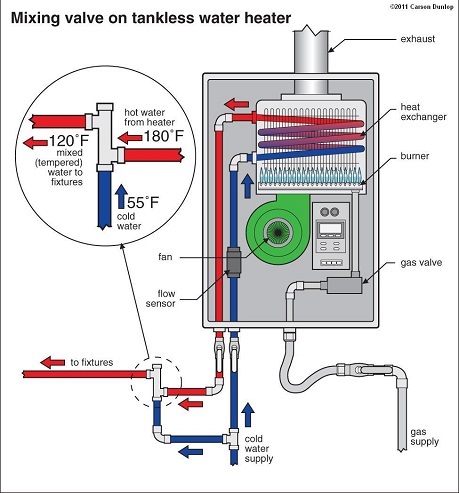
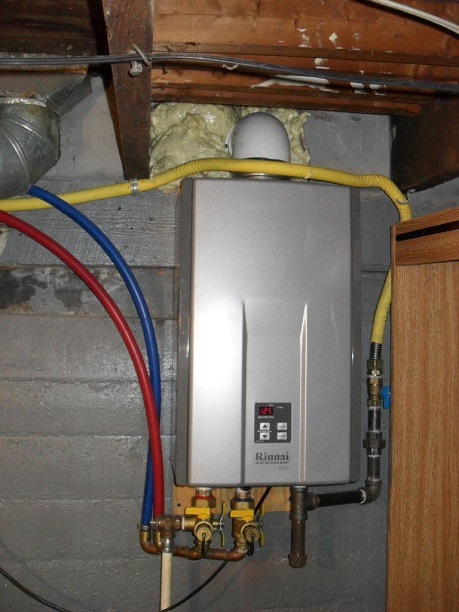
Typical gas fueled tankless water heater
Remote Control
Some tankless systems include a remote control that can be used to
monitor the performance of the system, view error codes and change the
desired water temperature.
Other
Uses
Tankless systems can also be used to heat the entire home,
as part of a forced air or radiant hot water system. In cold climates,
tankless systems are sometimes used to heat driveways on homes. This
saves a lot of snow shoveling.
Expensive
Although smaller than conventional
water heaters, tankless systems are considerably more sophisticated
and more expensive than conventional water heaters. Tankless water
heaters make a lot of sense and have been used for several decades in
Europe. They are newer in North America, and there have been some
issues in satisfying North American lifestyles.
Inspection Conditions
Let’s look at some of the
issues with tankless water heaters. In most cases the implication is
not enough hot water. The basic inspection strategy is to operate at
least two hot water faucets simultaneously to ensure adequate
delivery. It is good to run the water for at least two minutes, and
include a bathtub faucet because of the good flow rate.
1. Fuel supply problems
2. Scale buildup
3. Longer wait
4. Limited flow
5. Minimum flow rate problem
6. Cold water sandwich
7. Relief valve problems
8. Filter problems
9. Reliability and maintenance issues
We won’t be able to discuss all of these in detail, but let’s go
over the two common complaints: longer wait and maintenance issues.
Longer Wait
When a hot water faucet is
turned on, it may take longer to get hot water with a tankless water
heater than a conventional system. Tankless water heaters are
typically activated by flow through the hot water side of the
system. A hot water tap opened just a little bit may not create
enough flow to turn the water heater on. The flow through the hot
water side of a system with a tankless heater may be lower since,
instead of the water passing through a large tank, it passes through
a coil wrapped around a heat exchanger. This creates a more
restrictive path for the water. More friction loss means less flow.
This can be a nuisance but is not a critical problem. Better tank
locations and multiple tanks can help resolve the issue. On-demand
hot water circulating systems can be added to provide hot water more
quickly.

(story continues)
Reliability and Maintenance Issues
Conventional water heaters are
relatively simple and inexpensive. Tankless water heaters are more
expensive and more complex. More frequent repairs and higher
maintenance costs may be expected. Some home inspectors advise
customers to expect more maintenance issues with tankless water
heaters and recommend a service contract that includes regular
maintenance.
Despite the problems that
homeowners may face with tankless water heaters, there are many
benefits such as size, energy efficiency and reduced energy costs.
We can expect these systems to continue to improve and remain a
popular option for many homeowners. Because of their complexity and
importance to the occupant, home inspectors need to gain a good
understanding of how they work and what things can go wrong.
Alan Carson is Past President of the American Society of Home
Inspectors (ASHI) and principal in Carson Dunlop, one of Canada’s
largest home inspection firms, founded in 1978. Carson Dunlop is
distributors of the
ASHI@HOME
training program home study, Horizon report writing and
business management system, the Home Reference Book and Technical
Reference Guide, which identifies the age and size of HVAC
equipment.
ATTENTION: You are receiving WRE Online News because you opted in at WorkingRE.com or purchased E&O insurance from OREP. WRE Online News Edition provides news-oriented content twice a month. The content for WRE Special Offer Editions is provided by paid sponsors. If you no longer wish to receive these emails from Working RE, please use the link found at the bottom of this newsletter to be removed from our mailing list.




